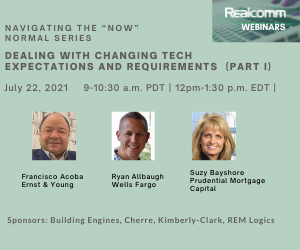CBRS in the Built Environment: Are We Ready?

When the FCC announced the release of 150 MHz of spectrum to the wireless community, countless companies clamored to develop products, services and hardware to take advantage of a massive market disruption. Infrastructure providers, carriers, third party vendors, cable companies and savvy enterprises all saw an opportunity: lower latency, increased bandwidth, heightened security, and reduced capital expenditure.
This newly available spectrum, 3.5 MHz or “Three-dot-five” (known as Citizens Broadband Radio Service aka CBRS), remains a backup ship-to-shore avenue for naval transmission; now to be shared by the public. While mobile network operators continue to purchase spectrum at auction, CBRS is uniquely positioned as lightly restricted shared spectrum available for anyone capable of implementing it as a powerful alternative to cellular or WiFi, which is often cluttered and unsecure.
What does this mean then for providing connectivity in the built environment? Historically, a Distributed Antenna System (DAS) was the technology of choice for premium indoor and dense outdoor venues – notably sports stadiums and arenas, transit, convention centers, shopping malls, and large hotels. DAS was economically unviable for small to medium density environments such as boutique hotels, most retail developments, and enterprise (office or industrial) buildings. This new technology bridges that gap. A private 5G network alleviates the constraints of traditional networks, yielding cutting-edge connectivity and IoT integration at a manageable price point.
The CBRS Alliance, now OnGo Alliance, was formed as an entity to ensure that the spectrum was realized (both as GAL and PAL) to manage interoperability concerns, control equipment certifications, and provide protocols for the use of the spectrum and technology. More importantly, this group endeavors to balance competing interests in a highly competitive environment.
From inception, the alliance realized that challenges would be plentiful. How do we monetize this new technology? When will we see CBRS capable chipsets proliferate the user market? Are we still looking at a three-year average turnover for adoption of new devices? What are the legal hurdles to data collection? Will we be able to continue our lucrative DAS business as the legacy model dwindles? Will carriers still pay infrastructure (tower) companies for sites? How will small cells play into the equation? Will property owners be willing to foot the bill for coverage? If we don’t adapt, will we be another Kodak entering the digital world?
Facial recognition, data collection, demographic information, IoT systems integration, push-to-talk capability, first responder assistance, etc. are all possible. How do we as an industry successfully navigate these opportunities and challenges?
On the Realcomm webinar on May 6, these questions were addressed with yet even more questions posed. In short, excitement remains fever pitch with new entrants to the market and creative financial structures are abounding. CBRS allows creative financial structuring and it is clear that one shoe does not fit all. AMT, CCI, SBA, and other REITs will face challenges with tax restrictions. Essentially, with REIT status dependent upon 75% of income required from “ongoing real estate related activity” IRC Code Section 856(c)(2,3), their contracts must be structured to look like leases or investments rather than service contracts. This opens the door for smaller shops to provide solutions to property owners in a nimbler fashion. The challenge for these smaller players then, is to compete with the scale and established credibility of those firms and relationships.
IoT integration and data collection begets a fresh opportunity for software developers, advertisers, and operators. CBRS is, by design, an open platform similar to mobile-based apps so prevalent in our world, enabling skilled designers and engineers to create meaningful graphical user interfaces and products on the platform. Because of this, CBRS can provide additional sources of revenue to all parties involved. Now the question becomes… who can access this info, who owns it, is it legal to collect it, is it legal to use it, and how?
Imagine walking into a casino. From the minute you step onto the property within range of the CBRS system, your phone or device links automatically to the system without “asking” permission. Similarly, our devices hand off signal source driving down the highway from tower to tower. Instantaneously, the system knows what language you speak, your phone habits, and can use algorithms to estimate your interests and shopping preferences. That system triggers the kiosk in front of you to push tailored advertising to your line of sight. It can follow you to your room, know when you sleep, visit the restroom, go to dinner, determine how long you stay at a bar or particular gaming spot, and more. While a gold mine of information for the advertising world and the casino owner may exist, this concept may concern customers. Inevitably, best practices for data collection and the ultimate legality of the same will be discussed ad nauseum as systems are deployed.
On the other side of the coin, data collection ability provides a unique upside to the end user with regard to safety. First responders can locate persons in a building during emergencies and develop strategies prior to arrival on-scene. Furthermore, healthcare providers can access, transmit, and receive critical information with ease.
The socioeconomic climate stemming from Covid-19 has no doubt shaken the world. More people shop and work remotely than ever before. Mobile communication is here to stay and nearly every property or business owner is looking at mobile strategy. This exponential growth of wireless demand will continue. Higher demand plus higher bandwidth (shorter signal propagation) means more sites needed at greater density. More IoT integration plus more devices equals more opportunity. More unregulated market entrants and more personal data available equals more demand for fiscal and ethical responsibility. Are we as an industry, economy and country ready for that responsibility?
This Week’s Sponsor
iOFFICE | Corporate Real Estate Management For A Changing Landscape: The future of real estate management belongs to corporate real estate leaders who are flexible. But you can only seize these opportunities if you have full visibility into how occupants are using your spaces — and how your game plan impacts your portfolio. www.iofficecorp.com
Read Next
 5/15/2025
5/15/2025
Tech, Talent and Transformation: 2025 Digie Finalists Announced For 27 years, Realcomm has presented the Digie Awards to acknowledge companies, real estate projects, technologies, and individuals that have advanced the commercial real estate industry through the strategic use of technology, automation, and innovation.
 5/15/2025
5/15/2025
Empowering Space Management with Data-Driven Visualization For effective CRE space management, it’s critical to centralize lease data, maximize rental square footage (RSF), improve energy efficiency and reconfigure spaces to meet changing needs.
 5/8/2025
5/8/2025
The AI-Powered Workplace Evolution: Redefining the Business Landscape In today's rapidly evolving business environment, the fusion of Artificial Intelligence (AI) and Workplace Management is revolutionizing the way organizations approach workspace optimization and operational efficiency.
 3/27/2025
3/27/2025
The Convergence of Edge Computing, Cloud, and AI in Building Automation and Smart Buildings In the built environment, we have seen the convergence of Operational Technology (OT) and Information Technology (IT), later expanding to include Workplace Technologies (WP).



%20(1)%20(1)%20(1).png)









